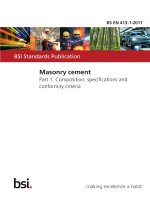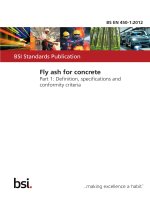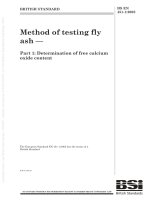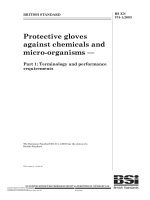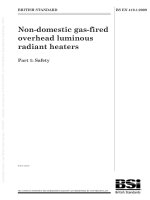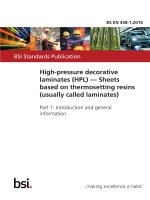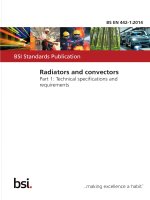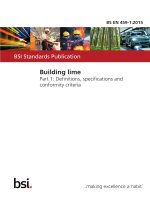Bsi bs en 00480 1 2014
Bạn đang xem bản rút gọn của tài liệu. Xem và tải ngay bản đầy đủ của tài liệu tại đây (1.13 MB, 14 trang )
BS EN 480-1:2014
BSI Standards Publication
Admixtures for concrete,
mortar and grout — Test
methods
Part 1: Reference concrete and reference
mortar for testing
BS EN 480-1:2014
BRITISH STANDARD
National foreword
This British Standard is the UK implementation of EN 480-1:2014. It
supersedes BS EN 480-1:2006+A1:2011 which is withdrawn.
The UK participation in its preparation was entrusted to Technical
Committee B/517/3, Admixtures.
A list of organizations represented on this committee can be
obtained on request to its secretary.
This publication does not purport to include all the necessary
provisions of a contract. Users are responsible for its correct
application.
© The British Standards Institution 2014. Published by BSI Standards
Limited 2014
ISBN 978 0 580 85500 9
ICS 91.100.30
Compliance with a British Standard cannot confer immunity from
legal obligations.
This British Standard was published under the authority of the
Standards Policy and Strategy Committee on 30 November 2014.
Amendments issued since publication
Date
Text affected
BS EN 480-1:2014
EN 480-1
EUROPEAN STANDARD
NORME EUROPÉENNE
EUROPÄISCHE NORM
October 2014
ICS 91.100.10; 91.100.30
Supersedes EN 480-1:2006+A1:2011
English Version
Admixtures for concrete, mortar and grout - Test methods - Part
1: Reference concrete and reference mortar for testing
Adjuvants pour béton, mortier et coulis - Méthodes d'essai Partie 1: Béton et mortier de référence pour essais
Zusatzmittel für Beton, Mörtel und Einpressmörtel Prüfverfahren - Teil 1: Referenzbeton und Referenzmörtel
für Prüfungen
This European Standard was approved by CEN on 14 September 2014.
CEN members are bound to comply with the CEN/CENELEC Internal Regulations which stipulate the conditions for giving this European
Standard the status of a national standard without any alteration. Up-to-date lists and bibliographical references concerning such national
standards may be obtained on application to the CEN-CENELEC Management Centre or to any CEN member.
This European Standard exists in three official versions (English, French, German). A version in any other language made by translation
under the responsibility of a CEN member into its own language and notified to the CEN-CENELEC Management Centre has the same
status as the official versions.
CEN members are the national standards bodies of Austria, Belgium, Bulgaria, Croatia, Cyprus, Czech Republic, Denmark, Estonia,
Finland, Former Yugoslav Republic of Macedonia, France, Germany, Greece, Hungary, Iceland, Ireland, Italy, Latvia, Lithuania,
Luxembourg, Malta, Netherlands, Norway, Poland, Portugal, Romania, Slovakia, Slovenia, Spain, Sweden, Switzerland, Turkey and United
Kingdom.
EUROPEAN COMMITTEE FOR STANDARDIZATION
COMITÉ EUROPÉEN DE NORMALISATION
EUROPÄISCHES KOMITEE FÜR NORMUNG
CEN-CENELEC Management Centre: Avenue Marnix 17, B-1000 Brussels
© 2014 CEN
All rights of exploitation in any form and by any means reserved
worldwide for CEN national Members.
Ref. No. EN 480-1:2014 E
BS EN 480-1:2014
EN 480-1:2014 (E)
Contents
Page
Foreword ..............................................................................................................................................................3
1
Scope ......................................................................................................................................................5
2
Normative references ............................................................................................................................5
3
3.1
3.2
3.2.1
3.2.2
3.3
Constituent materials ............................................................................................................................5
Cement ....................................................................................................................................................5
Aggregate ...............................................................................................................................................6
Aggregate for reference concrete ........................................................................................................6
Aggregate for reference mortar............................................................................................................6
Mixing water ...........................................................................................................................................6
4
Reference concrete ...............................................................................................................................6
5
Reference mortar ...................................................................................................................................7
6
6.1
6.2
Production of reference concrete ........................................................................................................7
Mix proportion ........................................................................................................................................7
Mixing and testing .................................................................................................................................7
7
7.1
7.2
Production of reference mortar ............................................................................................................8
Mix proportions ......................................................................................................................................8
Mixing and testing .................................................................................................................................8
8
Test report ..............................................................................................................................................9
2
BS EN 480-1:2014
EN 480-1:2014 (E)
Foreword
This document (EN 480-1:2014) has been prepared by Technical Committee CEN/TC 104 “Concrete and
related products”, the secretariat of which is held by DIN.
This European Standard shall be given the status of a national standard, either by publication of an identical
text or by endorsement, at the latest by April 2015 and conflicting national standards shall be withdrawn at the
latest by April 2015.
Attention is drawn to the possibility that some of the elements of this document may be the subject of patent
rights. CEN [and/or CENELEC] shall not be held responsible for identifying any or all such patent rights.
This document supersedes EN 480-1:2006+A1:2011.
The main changes with respect to the previous edition are listed below:
a)
amendment of the cement range;
b)
editorial revision according to CEN Internal Regulations.
This European Standard is part of the series EN 480 Admixtures for concrete, mortar and grout — Test
methods which comprises the following:
—
Part 1: Reference concrete and reference mortar for testing
—
Part 2: Determination of setting time
—
Part 4: Determination of bleeding of concrete
—
Part 5: Determination of capillary absorption
—
Part 6: Infrared analysis
—
Part 8: Determination of the conventional dry material content
—
Part 10: Determination of water soluble chloride content
—
Part 11: Determination of air void characteristics in hardened concrete
—
Part 12: Determination of the alkali content of admixtures
—
Part 13: Reference masonry mortar for testing mortar admixtures
—
Part 14: Determination of the effect on corrosion susceptibility of reinforcing steel by potentiostatic
electro-chemical test
—
Part 15: Reference concrete and method for testing viscosity modifying admixtures
This standard is applicable together with the standards of the series EN 934 Admixtures for concrete, mortar
and grout.
3
BS EN 480-1:2014
EN 480-1:2014 (E)
According to the CEN-CENELEC Internal Regulations, the national standards organizations of the following
countries are bound to implement this European Standard: Austria, Belgium, Bulgaria, Croatia, Cyprus, Czech
Republic, Denmark, Estonia, Finland, Former Yugoslav Republic of Macedonia, France, Germany, Greece,
Hungary, Iceland, Ireland, Italy, Latvia, Lithuania, Luxembourg, Malta, Netherlands, Norway, Poland, Portugal,
Romania, Slovakia, Slovenia, Spain, Sweden, Switzerland, Turkey and the United Kingdom.
4
BS EN 480-1:2014
EN 480-1:2014 (E)
1
Scope
This European Standard specifies the constituent materials, the composition and the mixing method to
produce reference concrete and reference mortar for testing the efficacy and the compatibility of admixtures in
accordance with the series EN 934.
2
Normative references
The following documents, in whole or in part, are normatively referenced in this document and are
indispensable for its application. For dated references, only the edition cited applies. For undated references,
the latest edition of the referenced document (including any amendments) applies.
EN 196-1, Methods of testing cement - Part 1: Determination of strength
EN 196-2, Method of testing cement - Part 2: Chemical analysis of cement
EN 196-6, Methods of testing cement - Part 6: Determination of fineness
EN 197-1, Cement - Part 1: Composition, specifications and conformity criteria for common cements
EN 413-2, Masonry cement - Part 2: Test methods
EN 934 (all parts), Admixtures for concrete, mortar and grout
EN 1008, Mixing water for concrete - Specification for sampling, testing and assessing the suitability of water,
including water recovered from processes in the concrete industry, as mixing water for concrete
EN 12350-2, Testing fresh concrete - Part 2: Slump-test
EN 12350-5, Testing fresh concrete - Part 5: Flow table test
EN 12350-6, Testing fresh concrete - Part 6: Density
EN 12350-7, Testing fresh concrete - Part 7: Air content - Pressure methods
EN 12390-1, Testing hardened concrete - Part 1: Shape, dimensions and other requirements for specimens
and moulds
EN 12390-2, Testing hardened concrete - Part 2: Making and curing specimens for strength tests
EN 12620, Aggregates for concrete
3
Constituent materials
3.1 Cement
The reference concrete and mortar shall be made with a CEM I cement of strength class 42,5 or 52,5
conforming to EN 197-1.
The cement used shall have a C3A content of 7 % to 11 % by mass calculated from chemical analysis
according to EN 196-2 and a specific surface of (3 200 to 4 600) cm2/g determined according to EN 196-6.
5
BS EN 480-1:2014
EN 480-1:2014 (E)
3.2 Aggregate
3.2.1
Aggregate for reference concrete
A natural normal weight aggregate conforming to EN 12620 with low water absorption (less than 2 % by
mass) shall be used. The size fractions of the aggregate used in the production of reference concretes shall
lie within the limits given in Table 1.
Table 1 — Aggregate for reference concrete
Aperture size
(mm)
Percentage by mass passing the test sieve
31,5
100
16,0
75 to 95
8,0
45 to 70
4,0
35 to 50
2,0
25 to 40
1,0
20 to 35
0,5
10 to 25
0,25
4 to 12
0,125
1 to 8
a) b)
a) The range is selected to accommodate both crushed and uncrushed aggregate.
b) The variation in the quantity passing each sieve of the chosen grading for both mixes (control and test
mix) shall not exceed ± 2,0 % by mass.
3.2.2
Aggregate for reference mortar
Standard sand according to EN 196-1 shall be used as the aggregate for the reference mortar.
3.3 Mixing water
Water according to EN 1008 shall be used as mixing water.
Distilled or de-ionised water may be used in special cases.
It is not allowed to use wash water from concrete production.
4
Reference concrete
Unless otherwise specified, tests on reference concrete are performed as comparative tests. That is, the
performance of admixtures is determined by comparing the reference concrete containing an admixture (test
mix) with the reference concrete made without an admixture (control mix) but otherwise with the same
aggregate/cement ratio and constituent materials from the same delivery.
The requirements of reference concretes shall be as given in Table 2. The fresh concrete shall be fully
compacted. The air content in the control mix shall not exceed 2 % by volume.
6
BS EN 480-1:2014
EN 480-1:2014 (E)
Table 2 — Requirements for reference concrete
Reference concrete
Cement content
kg/m3
I
c)
a)
Consistence at required test temperature
Slump
(mm)
Flow
(mm)
350 ± 5
70 ± 10
400 ± 20
II
300 ± 5
120 ± 20
450 ± 20
III
350 ± 5
50 ± 10
350 ± 10
IV
350 ± 5
30 ± 10
350 ± 20
b), d)
a) When testing at equal w/c ratio the requirements for consistence shall only apply to the control mix.
b) These consistence tests are alternatives and have to be chosen before starting the test. Slump shall be
determined in accordance with EN 12350-2 or flow in accordance with EN 12350-5 respectively.
c) Control mix only: The resulting cement content of the test mix may change as a result of volume change
to concrete caused by water reducing or air entraining effects of the admixture under test.
d) For high range water reducing/superplasticising admixture the consistence of the test mix shall be not
less the consistence of the control mix with no upper limit on consistence of the test mix.
5
Reference mortar
Unless otherwise specified, tests on reference mortar are performed as comparative tests. That is, comparing
the performance of the reference mortar containing an admixture (test mix) with the performance of the
reference mortar without an admixture (control mix).
Standard mortar conforming to EN 196-1 shall be used as the reference mortar.
6
Production of reference concrete
6.1 Mix proportion
The cement content shall be in accordance with Table 2.
Aggregate shall be used in an oven dry condition (≥ 105 °C) to remove doubts on moisture content variation. If
the aggregate is not oven dry, its moisture content shall be determined and the specific gravity shall be
corrected accordingly. In case of dispute, oven dry aggregate shall be used.
The test mix shall have the same aggregate:cement ratio as the control mix but the water content shall be
adjusted to give a consistence within the limits given in Table 2 for the control mix. The water content of the
mix shall be calculated from the moisture content of the aggregate, the mixing water and the water content of
the admixture. In the case of the plasticised or superplasticised flowing concrete mix and when testing water
resisting admixtures at equal w/c ratio no water reduction shall be made.
6.2 Mixing and testing
Prior to mixing, each of the constituents shall be conditioned to a temperature of (20 ± 2) °C or when required
by the test method, to (5 ± 1) °C.
The following mixing technique shall be adopted to ensure repeatability of results, and eliminate initial
absorption effects on consistence:
Use a forced action pan mixer to its minimum of 50 % capacity (maximum 90 % of capacity).
Wipe the inside with a damp cloth if dry.
7
BS EN 480-1:2014
EN 480-1:2014 (E)
Add all of the aggregate to the pan mixer with half the mixing water. Mix for two minutes, then stand for two
minutes. Cover the pan mixer during the standing period to minimise evaporation effects.
Re-start the mixer for thirty seconds after or whilst adding the cement. Add the remaining water (plus
admixture in the test mix) over the next thirty seconds. Mix for two minutes.
In the case of powder admixture, the admixture shall be added to the dry constituents of the concrete unless
otherwise specified by the manufacturer.
Determine the consistence within five minutes from completion of mixing.
Immediately after mixing and initial testing, store the specimens at the required test temperature, (20 ± 2) °C
or (5 ± 1) °C.
If the consistence is outside the limit in Table 2, (except test mixes at equal w/c ratio and in accordance with
Table 2 footnote d) discard the mix and repeat at a revised water content.
Determine the density according to EN 12350-6 and check whether the cement content conforms to the
values given in Table 2. If the cement content is outside the limits discard the mix and repeat with a revised
content of cement, aggregate and water.
Measure air content according to EN 12350-7 and make specimens within 30 min from completion of mixing.
Unless otherwise specified in the standards of the series EN 934, three cubes or cylinders shall be taken for
compressive strength testing at each test age and results averaged for the assessment of compliance.
Prepare and cure the specimens in accordance with EN 12390-2 using moulds conforming to EN 12390-1. If
one of the specimens varies from the average for the set by more than 10 %, it shall be discarded and the
average recalculated on the remaining two specimens.
7
Production of reference mortar
7.1 Mix proportions
The proportion of cement and sand shall be in accordance with EN 196-1.
The amount of water added to the control mix shall be in accordance with EN 196-1. For test mixes the water
added shall be sufficient to give equal consistence to that of the control mix, except when testing water
resisting admixtures at equal w/c ratio.
7.2 Mixing and testing
The requirements of conditioning and temperature after mixing shall be as specified in 6.2.
Mix the dry sand and cement for 30 s at low speed in a mixer in accordance with EN 196-1.
Add all the water (plus admixture in the test mix) over the next 30 s at low speed.
In the case of a powder admixture, which is not soluble or dispersible, the admixture shall be added to the dry
constituents of the mortar unless otherwise specified by the manufacturer.
Continue mixing for 60 s at low speed.
Stop mixing and remove any unmixed material from the edge and bottom of the bowl using the mixing paddle
over a period of 30 s.
Re-start mixing and continue for a further 60 s at high speed. Total mixing time shall be 3 min 30 s.
8
BS EN 480-1:2014
EN 480-1:2014 (E)
Determine consistence in accordance with EN 413-2 by plunger, flow or workability within 5 min from
completion of mixing. If the plunger value of the test mix (except for mixes of equal w/c ratio) differs from the
control mix by more than 3 mm, discard the mix and repeat at a revised water content.
If the flow value of the test mix (except for mixes of equal w/c ratio) differs from that of the control mix by more
than 5 %, discard the mix and repeat at a revised water content.
When the consistence is measured by the workability method the test mix shall be discarded when it does not
comply with the following requirement:
to < 10 s
t = to ± 1 s
to = 10 s to 30 s
t = to ± 2 s
to > 30 s
t = to ± 0,08 to
where
to
is the workability of control mix;
t
is the workability of test mix.
8
Test report
The test report shall include the following information about the reference concrete and/or the reference
mortar:
For control and test concrete:
aggregate:
— source;
— crushed or uncrushed;
— type;
— grading;
— moisture content if not oven dry;
cement:
— source;
— cement notation and class in accordance with EN 197-1;
— C3A content;
— specific surface area;
control concrete and/or mortar:
— consistence;
— fresh bulk density;
9
BS EN 480-1:2014
EN 480-1:2014 (E)
— air content;
— details of other tests carried out on the mix;
test concrete and/or mortar:
— admixture dosage;
— consistence;
— fresh bulk density;
— air content;
— details of other tests carried out on the mix.
10
This page deliberately left blank
NO COPYING WITHOUT BSI PERMISSION EXCEPT AS PERMITTED BY COPYRIGHT LAW
British Standards Institution (BSI)
BSI is the national body responsible for preparing British Standards and other
standards-related publications, information and services.
BSI is incorporated by Royal Charter. British Standards and other standardization
products are published by BSI Standards Limited.
About us
Revisions
We bring together business, industry, government, consumers, innovators
and others to shape their combined experience and expertise into standards
-based solutions.
Our British Standards and other publications are updated by amendment or revision.
The knowledge embodied in our standards has been carefully assembled in
a dependable format and refined through our open consultation process.
Organizations of all sizes and across all sectors choose standards to help
them achieve their goals.
Information on standards
We can provide you with the knowledge that your organization needs
to succeed. Find out more about British Standards by visiting our website at
bsigroup.com/standards or contacting our Customer Services team or
Knowledge Centre.
Buying standards
You can buy and download PDF versions of BSI publications, including British
and adopted European and international standards, through our website at
bsigroup.com/shop, where hard copies can also be purchased.
If you need international and foreign standards from other Standards Development
Organizations, hard copies can be ordered from our Customer Services team.
Subscriptions
Our range of subscription services are designed to make using standards
easier for you. For further information on our subscription products go to
bsigroup.com/subscriptions.
With British Standards Online (BSOL) you’ll have instant access to over 55,000
British and adopted European and international standards from your desktop.
It’s available 24/7 and is refreshed daily so you’ll always be up to date.
You can keep in touch with standards developments and receive substantial
discounts on the purchase price of standards, both in single copy and subscription
format, by becoming a BSI Subscribing Member.
PLUS is an updating service exclusive to BSI Subscribing Members. You will
automatically receive the latest hard copy of your standards when they’re
revised or replaced.
To find out more about becoming a BSI Subscribing Member and the benefits
of membership, please visit bsigroup.com/shop.
With a Multi-User Network Licence (MUNL) you are able to host standards
publications on your intranet. Licences can cover as few or as many users as you
wish. With updates supplied as soon as they’re available, you can be sure your
documentation is current. For further information, email
BSI Group Headquarters
389 Chiswick High Road London W4 4AL UK
We continually improve the quality of our products and services to benefit your
business. If you find an inaccuracy or ambiguity within a British Standard or other
BSI publication please inform the Knowledge Centre.
Copyright
All the data, software and documentation set out in all British Standards and
other BSI publications are the property of and copyrighted by BSI, or some person
or entity that owns copyright in the information used (such as the international
standardization bodies) and has formally licensed such information to BSI for
commercial publication and use. Except as permitted under the Copyright, Designs
and Patents Act 1988 no extract may be reproduced, stored in a retrieval system
or transmitted in any form or by any means – electronic, photocopying, recording
or otherwise – without prior written permission from BSI. Details and advice can
be obtained from the Copyright & Licensing Department.
Useful Contacts:
Customer Services
Tel: +44 845 086 9001
Email (orders):
Email (enquiries):
Subscriptions
Tel: +44 845 086 9001
Email:
Knowledge Centre
Tel: +44 20 8996 7004
Email:
Copyright & Licensing
Tel: +44 20 8996 7070
Email:
